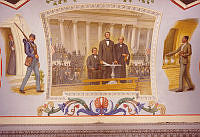Rubenstein Center Scholarship
The White House and Reconstruction
This article is part of the Slavery in the President’s Neighborhood initiative. Explore the Timeline
January 1, 1863 was a watershed moment in American history. That morning, President Abraham Lincoln hosted the annual New Year’s Day reception at the White House, spending several hours in the Blue Room shaking hands with hundreds of citizens. In the early afternoon, Lincoln returned to his office upstairs on the Second Floor. Secretary of State William Seward and his son, Frederick, brought the president the Emancipation Proclamation. Before taking his pen to this historic document, Lincoln was recorded as saying:
"I never in my life felt more certain that I was doing right than I do in signing this paper. But I have been shaking hands since nine o’clock this morning till my arm is stiff and numb. Now this signature is one that will be closely examined, and if they find my hand trembled, they will say, ‘he had some compunctions.’ But, anyway, it is going to be done."1
With those words and a slightly trembling hand, Abraham Lincoln signed the Emancipation Proclamation, declaring “that all persons held as slaves...shall be then, thenceforward and forever free.”2 Although this proclamation did not immediately eliminate slavery in the United States, it fundamentally altered the character of the Civil War, transforming it from a sectional conflict into a war for freedom and abolition. From that point forward, the road to reimagining America without slavery would be long and arduous. During and immediately following the Civil War, the United States faced the enormous task of piecing the war-torn nation back together after years of military conflict, economic devastation, social strife, and massive losses of life. In particular, this included grappling with the end of slavery, readmitting eleven secessionist states to the Union, and addressing Black suffrage. Over the course of fourteen years from 1863 to 1877, three presidents—Abraham Lincoln, Andrew Johnson, and Ulysses S. Grant—worked from the White House to reconcile and rebuild the United States.3 Click here to learn more about the household of President Abraham Lincoln.

On the final page of the Emancipation Proclamation, you can see President Abraham Lincoln's signature. He signed the document with slightly trembling hands after shaking hands with hundreds of citizens during the annual White House New Year's Day reception earlier that morning.
The National Archives and Records AdministrationInitial efforts to begin Reconstruction occurred prior to the end of the Civil War when President Abraham Lincoln began to implement policies aimed at “sectional reconciliation” between the North and South. During the early days of the conflict, Lincoln refrained from discussing the future of slavery in the United States after the Civil War, hoping to preserve and repair the Union without directly tackling the contentious issue. However, it became increasingly apparent that slavery would need to be addressed.
His first effort, the Emancipation Proclamation, freed enslaved people in the Confederate states. However, this did not apply to the border states—Maryland, Kentucky, West Virginia, Missouri, and Delaware. These states permitted slavery but did not secede from the Union. The proclamation also announced that Black men would be allowed to enlist in the Union Army. Although the proclamation did not free all of the nation’s enslaved people, it was a significant turning point. African-American men began enlisting in the Union Army in earnest, gaining equality before the law for the first time. The preeminent historian of Reconstruction Eric Foner explained, “The Emancipation Proclamation and the presence of Black troops ensured that, in the last two years of the war, Union soldiers acted as an army of liberation.”4 This shift in priorities demonstrated that the United States needed to begin the difficult process of reintegrating two separate societies with distinct economies; the North and the South.
On December 8, 1863, President Lincoln introduced his first plan for Reconstruction; the Proclamation of Amnesty and Reconstruction. This announcement offered a full pardon to those individuals that took an oath of loyalty and accepted the abolition of slavery. It also promised the “restoration of all rights of property, except as to slaves,” meaning that all landholdings and homes would be restored to members of the Confederacy, with the exception of enslaved people.5 This proclamation was part of Lincoln’s Ten-Percent Plan, a strategy that allowed Confederate states to rejoin the Union when ten percent of its voters swore an oath of allegiance to the Constitution. Lincoln likely never intended the Ten-Percent Plan to serve as a comprehensive blueprint for Reconstruction since the war was still ongoing. Instead, it was a preliminary effort meant to shorten the conflict and cement white support for emancipation by presenting rebels with a choice—surrender enabled the retention of land. However, Confederate states refused because it meant the end of slavery.6

This widely circulated engraving depicts the first reading of the Emancipation Proclamation in the Cabinet Room of the White House, in what is now the Lincoln Bedroom. The Emancipation Proclamation was signed on January 1, 1863 and granted freedom to enslaved people residing in Confederate states. Those present were (from left to right): Secretary of War Edwin M. Stanton, Secretary of the Treasury Salmon P. Chase, President Abraham Lincoln, Secretary of the Navy Gideon Welles, Secretary of the Interior Caleb B. Smith, Secretary of State William H. Seward, Postmaster General Montgomery Blair, and Attorney General Edward Bates.
Library of CongressPrior to the conclusion of the Civil War, state Reconstruction efforts first occurred in the border states with varied degrees of success. Maryland, West Virginia, and Missouri underwent internal reconstructions that reformed their state governments and abolished slavery, while Kentucky and Delaware protected the institution. Meanwhile, as Union forces captured areas of the South, Reconstruction efforts picked up momentum. In Tennessee, Union forces claimed Nashville in February 1862 and President Lincoln appointed Andrew Johnson as the state’s military governor. Previously, Johnson had chosen to remain in the United States Senate after Tennessee seceded from the Union and his loyalty was rewarded. At the end of 1863, Johnson and Unionists endorsed the Emancipation Proclamation and by 1864, ended slavery in Tennessee. For Johnson, a slave owner himself, ending slavery in Tennessee was based less upon the gross injustice of the institution and more on his strong hatred of the Confederacy.7 Click here to learn more about the enslaved household of President Andrew Johnson.
Still, Johnson’s loyalty elevated him to prominence within the Republican Party. In 1864, President Lincoln selected Andrew Johnson as his running mate for reelection. By choosing Johnson as his vice president, Lincoln hoped to balance the ticket with a southern leader who supported the Union.8
On April 9, 1865, Confederate General Robert E. Lee surrendered the Army of Northern Virginia to Union General Ulysses S. Grant, effectively ending the Civil War.9 As the Union celebrated, tragedy struck when President Lincoln was assassinated days later and died on April 15, 1865. Andrew Johnson ascended to the presidency, saddled with the monumental task of reconstructing the nation.

In this 1866 drawing by Alfred Waud, the African-American community in Little Rock, Arkansas celebrates as U.S. Colored Troops returned home at the end of the Civil War. The victorious soldiers were greeted by women and children.
Library of CongressBy most accounts, Johnson did not adequately rise to this occasion. Those that expected Johnson to take a strong position in punishing former Confederates and expanding Black suffrage were sorely mistaken. He announced his plan for Presidential Reconstruction on May 29, 1865, issuing two proclamations. The first granted amnesty and returned property to southerners willing to take a loyalty oath to the Constitution. However, many groups were excluded, including Confederate officials and wealthier planters with property valued at more than $20,000. Instead, these individuals had to personally apply for a pardon from the president.10 The second proclamation outlined a plan for North Carolina, which served as a blueprint for state efforts. He appointed a provisional governor and instructed North Carolina to call a convention to amend its prewar constitution for readmittance into the Union.11 When the plan was first announced, Johnson enjoyed widespread northern support, but cracks soon began to appear.
While serving as Tennessee's military governor in 1864, Johnson gave a speech declaring himself the “Moses of colored men” while also sharing his disdain for southern elites: “I am no agrarian, but if the princely plantation of Wm. G. Harding, who boasted that he had disbursed over $5,000,000 for the rebel Confederacy, were parcelled out among fifty loyal, industrious farmers, it would be a blessing to our noble Commonwealth.”12 This was a sentiment expressed by Johnson on several occasions prior to his presidency, leading people to believe Johnson would hold former Confederates accountable with severe punishments and penalties, as well as by enacting strict post-war regulations. This did not happen.

A photograph of the White House taken during either the Lincoln Administration or Johnson Administration.
Office of the Curator, The White HouseInstead, Johnson all but guaranteed the white South a free hand in managing its own affairs. During the summer of 1865, Johnson appointed provisional governors and states began amending their constitutions. Unfortunately, while the war ended slavery, Johnson’s lenient amnesty policies failed to abolish the “slaveocracy” that existed in the South prior to the Civil War. Instead, former enslavers and Confederates inserted themselves into these reform efforts. In fact, as his policies unfolded, the mild terms caused many southerners to view Johnson as more of an ally than an enemy.13
Johnson signaled this in several ways, including his generous and mild treatment of former Confederates. Although he cautiously granted pardons at first, by 1866, 7,000 of the 15,000 individuals excluded from general amnesty had received individual pardons directly from Johnson. This even included lenient treatment for former Confederate President Jefferson Davis. Despite serving two years in federal prison, Davis never faced trial for treason.14 The question remains—why would Johnson abandon an assault on Confederate elites?

On May 29, 1865, President Johnson issued this proclamation granting amnesty and the return of property to southerners willing to take a loyalty oath to the Constitution. The text of the oath stated: "I, ____, do solemnly swear, (or affirm) in presence of Almighty God, that I will henceforth faithfully support and defend the Constitution of the United States and the Union of the States thereunder, and that I will, in like manner, abide by and faithfully support all laws and proclamations which have been made during the existing rebellion with reference to the emancipation of slaves. So help me god."
Library of CongressAccording to Foner, the most likely explanation is that Johnson chose to cooperate with Confederates to guarantee his own reelection and safeguard white supremacy in the South.15 Based on his previous actions related to the abolition of slavery, some expected Johnson to support the expansion of voting rights and civil liberties for African Americans. However, as Frederick Douglass once noted, “he [Johnson] is certainly no friend to our race.”16 Johnson’s prejudices toward African Americans are well documented. During his annual message to Congress in 1867, Johnson stated:
"It must be acknowledged that in the progress of nations Negroes have shown less capacity for government than any other race of people. No independent government of any form has ever been successful in their hands. On the contrary, wherever they have been left to their own devices they have shown a constant tendency to relapse into barbarism."17
This racist statement was one of many that reveal Johnson’s disdain for African Americans. On another occasion Johnson’s private secretary, Colonel William G. Moore, recorded in his diary that the president, “has at times exhibited a morbid distress and feeling against the negroes” after Johnson discovered “half a dozen stout negroes” at work on the White House Grounds and demanded to know immediately whether “all of the white men have been discharged.”18
Johnson’s personal racism certainly extended outward to Reconstruction and he sometimes directly supported southern efforts to restrict freedoms for African Americans. In August 1865, Johnson ordered the removal of Black troops from the South after southerners complained that their presence was affecting morale. He also ordered the return of land to pardoned Confederates, directly defying the Commissioner of the Freedmen’s Bureau.19 The Freedmen’s Bureau was established as part of the War Department in 1865 to provide assistance to both formerly enslaved individuals and impoverished white people. Since the Civil War had displaced and impacted so many individuals, the Bureau issued food, clothing, and other supplies, operated hospitals, reunited families, provided employment opportunities, and assisted formerly enslaved people with settling on abandoned or confiscated lands.20 Undercutting this institution’s autonomy demonstrated Johnson’s limited interest in improving the conditions of the nation’s freedmen.

This photograph provides a rare, early glimpse of White House staff at work in 1862.
Collection of Set MomjianJohnson also did little to halt southern states’ conscious efforts to undermine freedoms for African Americans. The states were able to freely construct their new governments, as long as they abided by the guidelines. This allowed many states to enact Black Codes, laws limiting political, social, and economic freedoms for African Americans. By the end of 1865, both Mississippi and South Carolina had enacted the first and most harsh Black Codes. Mississippi required all African Americans to provide written evidence of employment each year and in the event that laborers left their contracts early they would forfeit their earned wages. Further restrictions prevented African Americans from having any occupation other than farmer or servant unless they were able to pay an annual tax. These restrictions and others caused an uproar, so other southern states enacted milder Black Codes that were nonetheless restrictive and discriminatory.21
Meanwhile, as Johnson’s policies rapidly lost support and Presidential Reconstruction came to a close, other changes were set in motion. On December 6, 1865, the Thirteenth Amendment was ratified, abolishing slavery in the United States: “Neither slavery nor involuntary servitude, except as a punishment for crime whereof the party shall have been duly convicted, shall exist within the United States, or any place subject to their jurisdiction.”22
In December 1865, the Thirty-ninth Congress convened for the first time. Because they were elected during the final days of the Civil War, both the House and Senate had a majority Republican legislative body, outnumbering Democrats three to one. A group of “Radical Republicans” in Congress called for state governments to expand universal male suffrage and uphold equality before the law. They also refused to seat representatives from southern states. By 1866, the Radical Republicans began passing civil rights legislation and extended the Freedmen’s Bureau. This powerful group of legislators were led by Pennsylvania Representative Thaddeus Stevens and Massachusetts Senator Charles Sumner.23
Johnson also did little to halt southern states’ conscious efforts to undermine freedoms for African Americans.
As Radical Republicans began passing progressive legislation, President Johnson fought back with his executive authority. In 1866, two important pieces of legislation were presented to Johnson. The first was a second Freedmen’s Bureau bill. The first bill, passed on March 3, 1865, created the bureau. The second piece of legislation aimed to extend the life of the Bureau by removing its expiration date and including freedmen from the entire United States—not just those living in formerly Confederate states.24 At the same time, representatives also drafted the Civil Rights Act of 1866, presenting the first major legislative attempt to give greater meaning to the Thirteenth Amendment. This act declared:
“That all persons born in the United States and not subject to any foreign power, excluding Indians not taxed, are hereby declared to be citizens of the United States; and such citizens, of every race and color, without regard to any previous condition of slavery or involuntary serviture, except as a punishment for crime…”25
After these bills passed in the House and Senate, they arrived on President Johnson’s desk at the White House. Republicans in Congress believed that the president would sign the legislation. However, Johnson vetoed the bills, creating a significant rift between the president and his own party. Johnson defended his vetoes, arguing that it was not necessary to extend the original Freedmen’s Bureau legislation, that it infringed upon states’ rights, and that it gave the federal government too much power in providing aid.26 He also argued that Reconstruction legislation should not be passed while eleven states remained unrepresented in Congress.27 When it came to his veto of the Civil Rights Act, Johnson outright rejected the underlying principle within the bill, arguing that offering citizenship to all Americans, except Native Americans, overstepped the authority of individual states and that “the distinction of race and color is by the bill made to operate in favor of the colored and against the white race.” In other words, Johnson believed that offering lawful protections to African Americans would undermine the power and authority of white males in favor of African Americans.28

This 1866 political cartoon depicts Johnson's veto of the Freedmen's Bureau Bill. It was originally published in Harper's Weekly Magazine.
House Divided Project at Dickinson CollegeCongress passed the civil rights and Freedmen’s Bureau legislation by overriding Johnson’s vetoes. The Freedmen’s Bureau bill became law on March 3 and the Civil Rights Act became law on April 9, 1866, a year to the day Confederate General Robert E. Lee surrendered the Army of Northern Virginia at Appomattox Court House. Although the legislation was eventually passed, Johnson’s vetoes were a highly visible confrontation between the executive and legislative branches. During the spring of 1866, Congress also introduced a number of provisions that would be combined to create the Fourteenth Amendment, guaranteeing citizenship to all Americans, including formerly enslaved people:
“All persons born or naturalized in the United States, and subject to the jurisdiction thereof, are citizens of the United States and of the state wherein they reside. No state shall make or enforce any law which shall abridge the privileges or immunities of citizens of the United States; nor shall any state deprive any person of life, liberty, or property, without due process of law; nor deny to any person within its jurisdiction the equal protection of the laws.”29
The Fourteenth Amendment also ensures “due process of law,” which was intended to prevent state and federal governments from discriminating against Black Americans. It also authorized the federal government to punish states if they infringed upon voting and civil rights. Congress passed the amendment on June 16, 1866, and submitted it to the states for ratification. The Amendment was ratified nearly two years later on July 9, 1868. Unfortunately, the amendment was flawed and efforts to undermine it quickly arose. For example, the amendment introduced the phrase “male” to the Constitution, indicating that voting rights would not be extended to women. Meanwhile, many states frequently and continuously violated the Fourteenth Amendment by enacting restrictive Black Codes including poll taxes and literacy tests designed to impede African Americans from exercising their right to vote.30
The next congressional term was fraught with dissension. Johnson continued to clash with the Fortieth Congress over Reconstruction, steadfastly refusing to compromise on protections under the law for Black Americans. The conflict came to a head on February 24, 1868, when the House of Representatives voted to impeach President Johnson. In an effort led by Congressman Thaddeus Stevens, a resolution of impeachment passed 126-47, and several days later the House of Representatives brought eleven articles of impeachment against the president.31 Most of the charges related to President Johnson’s violations of the Tenure of Office Act, where he removed Secretary of War Edwin Stanton improperly from his position.32 It also addressed an 1867 incident where Johnson had removed military commanders and replaced them with officers supportive of white rule in the South and later tried to create an “Army of the Atlantic” which would be headquartered in Washington, D.C. This was meant as an intimidation tactic against Congress. After taking steps to fire Stanton in the summer of 1867, Johnson attempted to replace him with General Ulysses S. Grant. However, Grant soon turned against the president after realizing Johnson was endangering the lives of American soldiers with his antics, aligning himself with the Radical Republicans ahead of his 1868 run for the presidency.33 The impeachment signaled war between the president and Congress. After the House submitted articles of impeachment, the Senate began its trial on March 4, 1868, concluding in May. Senators ultimately voted on three articles of impeachment. The trial ended in dramatic fashion when the Senate fell one vote short of the two-thirds necessary on all three articles to convict and remove Johnson from office. He served out the remainder of his term without popular or congressional support.34

This painting by George Peter Alexander Healy depicts four significant Union figures toward the end of the Civil War. In the cabin of the steamer River Queen are seated (from left to right) Maj. Gen. William Tecumseh Sherman, Lt. Gen. Ulysses S. Grant, President Abraham Lincoln, and Rear Admiral David D. Porter. The meeting took place in March 1865 on the James River in City Point, Virginia, less than a week before the fall of Petersburg, Virginia.
White House Collection/White House Historical AssociationUlysses S. Grant won the presidency in 1868 with an overwhelming victory after campaigning with the slogan, “Let Us Have Peace.” One of President Grant’s most significant accomplishments during Reconstruction was his effort to combat the Ku Klux Klan (KKK). This organization formed in Pulaski, Tennessee in 1865 immediately following the Civil War. Rooted in white supremacy and “Lost Cause” ideology, the KKK terrorized Black Americans with threats and violence while vowing to restore the glory of the Old South.35 Many white southerners joined the Klan, interested in preserving law and order for white people. Throughout the remainder of the nineteenth century, and continuing to the present day, the Ku Klux Klan has been responsible for countless acts of racial violence including the deaths of thousands of voters, lynchings of African Americans, the direct targeting of southern Republican leaders after the Civil War, and successful attempts to weaken the political power of African Americans.36 Click here to learn more about the enslaved household of President Ulysses S. Grant.
Ahead of the 1868 election, the Klan increased its activity, intimidating Republican voters with widespread violence. For example, in Arkansas, 2,000 murders occurred in connection with the 1868 election. Although the Klan made its position clear, these violent actions proved to many northerners that the South needed further punishment and regulation.37 Support soon grew for the Fifteenth Amendment, which ensured: “The rights of the citizens of the United States to vote shall not be denied or abridged by the United States or by any State on account of race, color, or previous condition of servitude.”38 The Fifteenth Amendment was ratified on February 3, 1870. That year also saw a number of formerly Confederate states including Virginia, Mississippi, and Texas readmitted to the Union.
Meanwhile, President Grant supported ongoing Reconstruction efforts to varying degrees of success. In response to the extreme violence in the South, Grant supported Congress in passing several pieces of legislation enforcing the Thirteenth, Fourteenth, and Fifteenth Amendments; the Enforcement Act of 1870, the Enforcement Act of 1871, and the Ku Klux Klan Act. The 1870 act intended to restrict the KKK and other white supremacist organizations from harassing African Americans and enacted penalties for interfering in any male citizen’s right to vote. A subsequent report investigated this violence and led to the 1871 act which added severe punishments for criminal offenders. The final piece of legislation, passed in April 1871, outlawed organizations threatening the constitutional rights and safety of citizens, including the KKK. It also allowed the president the ability to suspend the writ of habeas corpus or use the military in regions with terrorist activities.39
The rights of the citizens of the United States to vote shall not be denied or abridged by the United States or by any State on account of race, color, or previous condition of servitude.
Several months later, in October 1871, President Grant used the powers extended to him by the Ku Klux Klan Act when he directed federal troops to South Carolina to enforce civil rights legislation and protect African Americans from ongoing violence. While Grant acted decisively in the case of South Carolina, he was inconsistent with the use of the army, failing to send troops to other troubled areas of the South.40
Unfortunately, the measures implemented during Grant’s presidency to prevent violence and voter suppression were not successful beyond his administration.41 The election of 1876 was one of the most contentious elections in United States history and the outcome essentially ended Reconstruction as a federal endeavor. When it came time to choose Grant’s successor, tensions were growing within the federal government. Over time, Northerners became frustrated with Reconstruction and Radical Republicans, blaming problems on Black voters and deeming them inferior, further perpetuating racist ideology. The 1873 financial crisis had also plunged the United States into a depression, further impeding economic recovery in the South and corruption accusations leveled at Grant’s administration shook confidence in the government.42
For the 1876 election, Democrats put forward Governor Samuel Tilden of New York to run against Republican Governor Rutherford B. Hayes of Ohio. Although Tilden won the popular vote, he only obtained 184 electoral votes, just one vote shy of securing the presidency. Meanwhile, returns from Louisiana, Florida, and South Carolina were disputed and both sides claimed victory. Congress ultimately decided the election. Since Republicans controlled the Senate and Democrats controlled the House of Representatives, a bipartisan electoral commission consisting of five representatives, five senators, and five Supreme Court justices settled the issue of the contested votes. Voting strictly along party lines, the commission awarded the electoral votes from all three contested states to Hayes. He became president by a single electoral vote.43
However, while the commission deliberated over the election’s outcome, southern Democrats met secretly with Republicans allied with Hayes to negotiate his election. Ultimately, the Democrats agreed not to block Hayes’ election if Republicans agreed to withdraw all federal troops from the South, allowing Democrats to consolidate power in the region and reestablish control. Within two months of taking office, Hayes had removed federal troops guarding statehouses in South Carolina and Louisiana, effectively ending Reconstruction.44

This 1867 print by Francis Ratellier depicts a grand allegory of the reconciliation. In this image, a flattened dome featuring a map of the United States sits atop a drum featuring the Senate, House of Representatives, Supreme Court, and Cabinet. The drum is supported by columns representing the states and the people. An eagle with a flag and shield sits atop the dome. The structure is undergoing "reconstruction" as the bases of the columns of former Confederate states are replaced with new ones. These old bases are called the "Foundations of Slavery." The new bases represent justice, liberty, and education. A number of other historical figures are represented in the painting including Ulysses S. Grant, Robert E. Lee, Daniel Webster, John C. Calhoun, and Joan of Arc, Horace Greeley, and Jefferson Davis.
Library of CongressThe end of federal control in the South ultimately led to increased disenfranchisement and intimidation of Black voters. With the end of Reconstruction marked traditionally as 1877, the final year of Grant’s presidency and transition to Rutherford B. Hayes, many of the policies put in place to help formerly enslaved individuals and enfranchise Black citizens were quickly set aside, ignored, or altered to ensure white supremacy. Although many African-American men gained the right to vote during Reconstruction, Black Codes continued to limited their freedoms—keeping them from the polls, arresting them for minor infractions, and establishing a system of penal labor called “convict leasing,” where Black men arrested for vagrancy were forced to work as unpaid laborers.45 In addition, economic devastation in the South led to the rise of a new system of labor exploitation—sharecropping. Under this system, many formerly enslaved Black families and poor white families rented land from white owners to raise cash crops—but the terms of the contracts were set by employers, ensuring that those that worked the land received little for their efforts. Although sharecropping varied depending on the location, crops, and time period, this exploitative system resembled slavery. Contracts kept workers under strict control. If the contracts were violated, offenders often went to jail, feeding into a prison system of unpaid labor.46
By the 1890s, Jim Crow laws began to be implemented across the South in earnest, segregating public spaces, schools, and businesses, further restricting the rights and freedoms of African Americans. The effects of Reconstruction are still felt today as the nation continues to grapple with its complicated past, hoping to reconcile over 400 years of racial violence and discrimination and realize an equal and just society where "all men are created equal" as originally promised in the Declaration of Independence.










